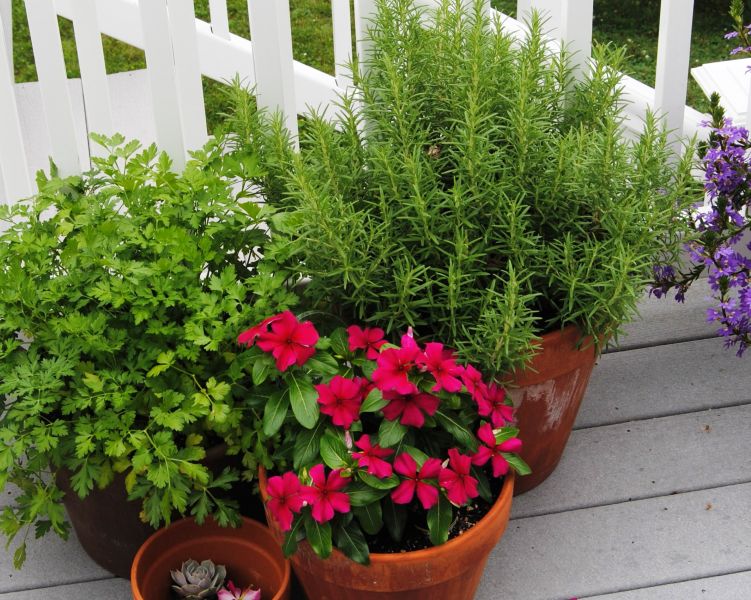
Fragrant Rosemary to Grow Indoors or Out
Share
Rosemary is a natural for hot sunny gardens. Originating in the hills surrounding the  Mediterranean, there are varieties that are equally at home in our mountain gardens. If you have struggled with a not-so-green thumb, a type of this fragrant evergreen that blooms most of the year should be on your list. Heck, I'm a gardener and I love to plant this easy to grow herb, especially since javalina, rabbits, and deer never bother with it. There are many kitchen recipes calling for fresh herbs, and this is one flavor that most people enjoy.
Mediterranean, there are varieties that are equally at home in our mountain gardens. If you have struggled with a not-so-green thumb, a type of this fragrant evergreen that blooms most of the year should be on your list. Heck, I'm a gardener and I love to plant this easy to grow herb, especially since javalina, rabbits, and deer never bother with it. There are many kitchen recipes calling for fresh herbs, and this is one flavor that most people enjoy.
 the plant in sunlight, and, if necessary, running a fan for a few hours a day to create a breeze.
Also be on the lookout for aphids and spider mites. These pests seem to like spending their winters on houseplants! Catching them before a total infestation of the plant will make them easier to control. Spray up to the day of harvest with organic Watters Home Harvest with neem oil to wipe out these pests.
the plant in sunlight, and, if necessary, running a fan for a few hours a day to create a breeze.
Also be on the lookout for aphids and spider mites. These pests seem to like spending their winters on houseplants! Catching them before a total infestation of the plant will make them easier to control. Spray up to the day of harvest with organic Watters Home Harvest with neem oil to wipe out these pests.
 Mediterranean, there are varieties that are equally at home in our mountain gardens. If you have struggled with a not-so-green thumb, a type of this fragrant evergreen that blooms most of the year should be on your list. Heck, I'm a gardener and I love to plant this easy to grow herb, especially since javalina, rabbits, and deer never bother with it. There are many kitchen recipes calling for fresh herbs, and this is one flavor that most people enjoy.
Mediterranean, there are varieties that are equally at home in our mountain gardens. If you have struggled with a not-so-green thumb, a type of this fragrant evergreen that blooms most of the year should be on your list. Heck, I'm a gardener and I love to plant this easy to grow herb, especially since javalina, rabbits, and deer never bother with it. There are many kitchen recipes calling for fresh herbs, and this is one flavor that most people enjoy.
Starting a Rosemary Plant
A nice landscape-sized rosemary plant can take years to fill out if started from seed. The seeds can be difficult to germinate and often don't grow true to their parent, so propagation usually is from cuttings. It can be started in a glass of water, but it will be difficult to transplant into soil with only water roots. If you want to start this herb from a cutting, it’s fairly easy to do. Here are the best steps to start your own rosemary plant:- Snip three 2-inch long cuttings from the soft, new growth of an established plant. Remember, plants from these cuttings will look just like their mother, so choose cuttings from a beautiful plant.
- Remove the leaves from the bottom inch of each cutting and dip it into Bonides Rooting Powder, available here at Watters.
- Carefully place the dipped ends into a container of dampened Seedling Potting Soil.
- Stick 3 cuttings into each pot to ensure against cutting failures.
- Place the container in a warm spot with indirect sunlight.
- Mist the cuttings daily and make sure the soil does not dry out completely.
Bringing Rosemary Indoors
It can be a little trickier to keep rosemary happy inside. Your rosemary plant requires 6 hours of full sun, so artificial lights may be necessary. Heat is not as crucial as sunlight. Since rosemary likes it on the dry side, glazed clay and terra cotta pots are especially good choices for this plant.Problems of Rosemary Plants
The biggest problem with growing rosemary indoors is its tendency for powdery mildew. Powdery mildew is a white, powdery fungus that can develop if the surrounding air is humid and there is not enough air movement. Keep the humidity low by allowing the soil to dry somewhat between waterings, keeping the plant in sunlight, and, if necessary, running a fan for a few hours a day to create a breeze.
Also be on the lookout for aphids and spider mites. These pests seem to like spending their winters on houseplants! Catching them before a total infestation of the plant will make them easier to control. Spray up to the day of harvest with organic Watters Home Harvest with neem oil to wipe out these pests.
the plant in sunlight, and, if necessary, running a fan for a few hours a day to create a breeze.
Also be on the lookout for aphids and spider mites. These pests seem to like spending their winters on houseplants! Catching them before a total infestation of the plant will make them easier to control. Spray up to the day of harvest with organic Watters Home Harvest with neem oil to wipe out these pests.
